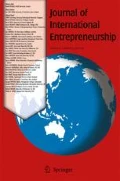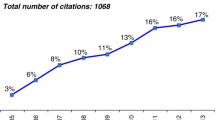Abstract
In this paper we will show how knowledge intensive firms can quicken their internationalisation by using the Internet as a sales channel. When properly applied the Internet can provide a way to decrease the effects of liability of foreignness and resource scarcity, and herewith contribute to an increased speed of internationalisation. The focus of the empirical research is on a Finnish knowledge intensive company and the development of its international operations and sales channels. The study applies the longitudinal case study method when examining in-depth the development of Futuremark Corporation for a period of five years.
Similar content being viewed by others
References
Barney J (1991) Firm resources and sustained competitive advantage. J Manage 17:99–120
Crick D, Jones MV (2000) Small high technology firms and international high technology markets. J Intern Market 8:63–85
Dana LP, Etemad H, Wright RM (1999) In: Wright R (eds) Research in global strategic management. JAI Press Inc, Stamford, Conn., pp. 3–22
Dunning JH, Wymbs C (2001) The challenge of Electronic Markets for International Business Theory. Intern J Eco Business 8:273–301
Eisenhardt KM (1989) Building theories from Case-Study Research. Acad Manage Rev 14:532–550
Gabrielsson M (1999) Sales channel strategies for international expansion. Helsinki School of Economics, Helsinki
Gabrielsson M, Kirpalani MVH, Luostarinen R (2002) Multiple Channels Strategies in the European Personal Computer Industry. J Intern Market 10:73–95
Gulati R (1998) Alliances and networks. Strat Manage J (19):293–317
Gulati R, Singh H (1998) The architecture of cooperation: managing coordination costs and appropriation concerns in strategic alliances. Admin Sci Quart 43:781–814
Hardy KG, Magrath AJ, (1988) Marketing channel management. Foresman and Company USA, Scott Scott, Foresman and Company, USA
Hymer S (1976) The international operations of national firms: a study of direct investments. MIT Press
Johanson J, Vahlne J-E (1977) The internationalization process of the firm-A model of knowledge development and increasing foreign market commitments. J Intern Bus Stud 8:23–32
Karagozoglu N, Lindell M (1998) Internationalization of small and medium-sized technology-based firms: An exploratory study. J Small Bus Manage 44–59
Kotha S, Rindova VP, Rothaermel FT (2001) Assets and actions: Firm-specific factors in the internationalization of U.S. Internationalization of the firm. J Intern Bus Stud 32:769–791
Luostarinen R (1979) Internationalization of the firm. Helsinki School of Economics and Business Administration, Helsinki, Finland
Luostarinen R, Gabrielsson M (2004) Finnish Perspectives of International Entrepreneurship. In: Dana, LP (ed) Handbook of research on international entrpreneurship. Edward Elgar: Cheltenham
McDougall PP, Shane S, Oviatt BM (1994) Explaining the formation of international new ventures—the limits of theories from international-business research. J Bus Venturing 9:469–487
Oviatt BM, McDougall PP (1994) Toward a theory of international new ventures. J Intern Bus Stud 25:45–64
Peteraf MA (1993) The cornerstones of competitive advantage: A resource-based view. Strat Manage J 14:179–191
Petersen B, Pedersen (1999) Fast and slow resource commitments to foreign markets: What causes the difference? J Intern Manage 5:73–91
Porter ME (2001) Strategy and the Internet. Harvard Business Review 63–78
Preece SB, Miles G, Baetz MC (1999) Explaining the international intensity and global diversity of early-stage technology-based firms. J Bus Venturing 14:259–281
Shrader R, McDougall PP, Oviatt BM (2000) How new ventures exploit trade-offs among international risk factors: Lessons for accelerated internationalization of the 21st century. Acad of Manage J 43:1227–1247
Singh N, Kundu S (2002) Explaining the growth of E-commerce corporations (ECCs): An extension and application of the eclectic paradigm. J Intern Bus Stud 33:679–697
Stinchcombe AL (1965) In: March JG (eds) Handbook of Organizations. Chicago, pp. 142–193
Yin RK (1991) Case study method sage. Newbury Park, CA
Zaheer S (1995) Overcoming the liability of foreignness. Acad Manage J 38:341–363
Zahra SA, George G (2001) International entrepreneurship: the current status of the field and future research agenda. Georgia State University, Atlanta
Author information
Authors and Affiliations
Corresponding author
Rights and permissions
About this article
Cite this article
Arenius, P., Sasi, V. & Gabrielsson, M. Rapid internationalisation enabled by the Internet: The case of a knowledge intensive company. J Int Entrepr 3, 279–290 (2005). https://doi.org/10.1007/s10843-006-7856-x
Issue Date:
DOI: https://doi.org/10.1007/s10843-006-7856-x




